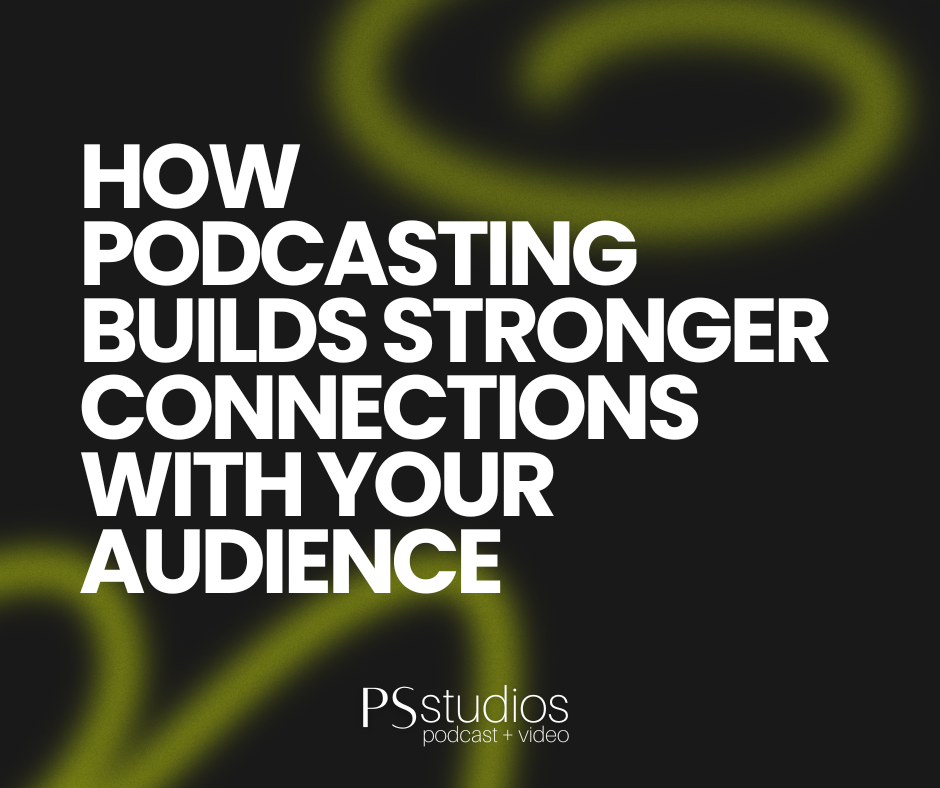
How Podcasting Builds Stronger Connections with Your Audience: Practical Insights
Podcasting builds stronger connections with your audience by offering an intimate and authentic way to communicate. Your voice conveys emotion and sincerity that text can’t, creating a personal bond with listeners. To effectively launch your podcast, it’s crucial to build hype by creating a grand opening, reaching out to potential listeners, and producing engaging podcast trailers to generate excitement and anticipation before the show airs. This article will explore how podcasting builds stronger connections with your audience, fostering trust, loyalty, and deeper engagement, while providing you with practical strategies to connect with your audience.
Introduction to Podcasting
Podcasting has rapidly become a popular way to create and share audio content with a wide audience, allowing podcasters to connect with listeners and build a community around their show. With the rise of podcasting, it’s easier than ever to create and distribute audio content, making it a great way for individuals and businesses to reach new audiences and build their brand.
Podcasts can be found on various platforms, including Apple Podcasts, Spotify, and Google Podcasts, making it easy for listeners to find and subscribe to their favorite shows. This accessibility has contributed to podcasting becoming a major form of entertainment and education, with millions of episodes available on various topics, from fiction podcasts to educational content.
Whether you’re a seasoned podcaster or just starting out, understanding the basics of podcasting is essential to creating a successful show and building a loyal audience. By mastering the fundamentals, you can create engaging content that resonates with your listeners and fosters a strong sense of community.
Key Takeaways
- Your voice creates a personal bond with listeners, making podcasting an intimate medium for connection.
- Engaging content and listener feedback are crucial for enhancing podcast relevance and fostering a loyal community.
- Consistency in episode releases and utilizing social media are key strategies for maintaining audience engagement and growing your listener base.
- Regularly publish episodes to maintain listener engagement and build a loyal audience. Consider strategies like the ‘soft open’ to refine content and establish a consistent release schedule.
Setting Up Your Podcast
Setting up a podcast requires some planning and preparation, but with the right tools and strategies, it can be a straightforward process. Choosing a format for your podcast is an important decision, as it will help guide the content and tone of your show, and attract the right audience.
Recording your first episode can be intimidating, but with a good microphone and recording software, you can create high-quality audio that will engage and retain your listeners. Additionally, creating a podcast website is essential, as it will provide a central hub for your show and allow listeners to find and subscribe to your podcast.
Setting up a podcast hosting service, such as Buzzsprout, will also help you distribute your podcast to various platforms and track your analytics. By taking these steps, you can ensure that your podcast is well-prepared to reach and engage your audience.
Choosing a Format
When choosing a format for your podcast, consider what type of content you want to create and what will resonate with your target audience. Fiction podcasts, for example, require a more scripted approach, while non-fiction podcasts may be more conversational.
Consider the length of your episodes, the frequency of your releases, and the tone you want to convey to your listeners. You can also experiment with different formats, such as interview-style podcasts or panel discussions, to find what works best for your show.
Ultimately, the format you choose will depend on your goals, resources, and target audience. By selecting the right format, you can create content that engages and resonates with your listeners.
Recording Your First Episode
Recording your first episode can be a daunting task, but with some preparation and practice, you can create a high-quality episode that will engage your listeners. Start by choosing a topic or theme for your episode, and create an outline to guide your conversation.
Invest in a good microphone and recording software, such as Audacity or Adobe Audition, to ensure high-quality audio. Find a quiet and comfortable space to record, and consider using headphones to monitor your audio.
Don’t be afraid to make mistakes or try again – it’s all part of the learning process, and you can always edit and refine your episode later. By taking these steps, you can create a compelling first episode that sets the tone for your podcast.
The Power of Your Voice

One of the most compelling aspects of podcasting is the power of your voices. Unlike writing words, podcasts enable listeners to hear your genuine voice, which can convey emotion, authenticity, and sincerity in a way that text simply cannot. This auditory connection transforms a mere broadcast into a meaningful exchange, fostering a sense of loyalty among your audience through sound effects.
Podcasting offers an intimate experience, creating a close bond between hosts and podcast listeners. When listeners hear your voice, they feel a stronger connection to you and your content, as if they’re part of a conversation rather than just passive recipients of information. This intimacy is a key factor in building trust and engagement with your audience as a podcaster.
Strengthen this bond by actively engaging with your listeners. Solicit their feedback, respond to their needs, and show appreciation. When your audience feels heard and valued, a deeper, more authentic connected forms, encouraging them to return.
Engaging Content Strategies
Engaging quality content is vital for a successful new podcast. Incorporate stories to deepen emotional connections with your listeners. Featuring less-known experts with unique insights can further set your podcast apart. Additionally, exploring fiction podcasts can enhance the variety of content you offer. Show notes are also crucial for enhancing SEO and accessibility, serving as informative summaries for each episode.
Engage deeply during interviews by practicing active listening, which leads to more dynamic conversations. Offering actionable content that listeners can apply in their lives enhances engagement, making your podcast both informative and practical. Listen to your audience while talking to better understand their needs and play off their feedback.
Encourage further exploration by offering additional resources related to your podcast topic to help your content gain traction. Staying focused on the main topic ensures your content remains relevant and valuable. Selecting topics you are passionate about can significantly boost engagement.
Building a Podcast Community

Podcasting is a powerful tool for fostering a sense of community among listeners with shared interests. Encourage listener participation by asking questions, which can inspire future episode content and strengthen audience connections. Establish an online presence on platforms like Twitter, Instagram, and Facebook to further engage your audience through your podcast platforms and podcast website. Joining groups and forums to engage with potential listeners and promote your podcast effectively can also direct traffic to your shows and drive new subscriptions.
Live shows and events promote deeper personal connections and strengthen the community. A welcoming atmosphere during these events can boost listener loyalty and foster word-of-mouth promotion, especially when shared in a Facebook group. Music supports can also play a significant role in enhancing the overall experience for the new group, the brand, and the world, providing essential support over the weeks on the website.
Read listener comments during episodes and mention audience members to foster appreciation and connection. Creative and inclusive engagement helps build a strong, loyal community around your podcast.
Leveraging Listener Feedback
Listener feedback is essential for understanding what resonates with your audience, including their interests and values. Simplifying the feedback process enhances their sense of value and yields more constructive insights.
Surveys effectively gather diverse opinions from users, identifying strengths and areas for improvement. Encouraging audience reviews provides insights and expands the feedback loop by promoting sharing among listeners. Additionally, collaborating with other podcasts can enhance exposure and listener engagement by tapping into new audiences and networks.
Creating Consistency with Regular Episodes
Consistency keeps your audience engaged. Regular episode releases foster anticipation and engagement, as listeners often incorporate podcasts into their routines, adjusting schedules to include new episodes.
A consistent release schedule creates a binge-worthy library, attracting new listeners and maintaining interest. Steady publishing is crucial to avoid ‘podfade,’ where creators gradually stop producing content. By focusing on one episode at a time, you can make meaningful progress and improvements, enhancing listener interactions and celebrating accomplishments.
Cross-Promoting with Other Podcasters

Cross-promotion involves podcasters promoting each other’s shows to reach new listeners. This strategy is often more cost-effective than traditional advertising, leveraging the trust listeners have in their favorite podcasters. Podcasters can also cross promote to expand their audience. Collaborating with podcast guests can further enhance the overall podcast experience, making it more engaging and beneficial for both hosts and listeners.
Episode swaps, where hosts create episodes for each other, are a popular cross-promotion method. Teaser ads can also attract new listeners by offering short previews of what a podcast trailer offers.
Select partners with similar target audiences but no direct competition for effective cross-promotion. Tracking metrics like audience reach, download numbers, and listener engagement evaluates the success of cross-promotion efforts.
Utilizing Social Media for Engagement
Choosing the right social media channels enhances engagement with your podcast audience. YouTube has become the preferred platform for adults in the US to consume podcasts, offering significant outreach opportunities. Ensuring your podcasts are available on every podcast app can also maximize visibility and listenership.
Social media highlights trends for content inspiration and fosters connections by sharing content. Utilizing social media engages podcast audiences, enhances visibility, and creates stronger connections.
Enhancing Accessibility with Transcripts
Transcripts for your podcast episodes enhance accessibility, broadening audience reach. They make audio file tools content accessible for individuals with hearing impairments and those who prefer to upload reading over listening, including video, while also providing a record of the discussions.
Including transcriptions of episodes improves accessibility and boosts search engine optimization for your podcast. Transcripts cater to varied learning preferences, aiding those who struggle with audio comprehension.
Hosting Live Shows and Events

Live podcasting allows for audience interaction during the recorded recording, fostering community and real-time feedback. Immediate feedback from the audience during live recordings enables podcasters to adjust content on the fly, creating a more dynamic and engaging experience.
Live shows create spontaneous and authentic moments, enhancing the listening experience. These events strengthen personal connections and foster a strong community feeling among listeners. Sharing the live show experience with friends can further build a community and enhance listener engagement.
Celebrating Milestones with Your Audience

Celebrating achievements boosts motivation and engagement among podcasters and their audience. Milestones like a specific number of episodes can be more meaningful than focusing solely on download metrics. Including past guests in celebrations enhances community connections and increases visibility.
Acknowledge milestones uniquely, such as with special episodes or giveaways, to create excitement and a sense of accomplishment.
Getting Listed in Directories
Getting listed in podcast directories, such as Apple Podcasts and Spotify, is essential to increasing your visibility and reach. To get listed, you’ll need to submit your podcast to each directory, providing information such as your podcast title, description, and cover art.
Make sure your podcast meets the directory’s guidelines and requirements, and be patient – it may take some time to get approved. You can also promote your podcast on social media and other online platforms to drive traffic to your show and increase your chances of getting listed.
Consider reaching out to other podcasters or influencers in your niche to cross-promote each other’s shows and gain traction in the podcasting community. By taking these steps, you can ensure that your podcast is accessible to a wider audience and continues to grow.
Interested in starting a podcast or upleveling your existing show? Schedule your free discovery call with our expert production team at PS Studios. During this call, we will discuss your goals, timeline, and how we can help. We work with clientele across the country and look forward to chatting with you!


